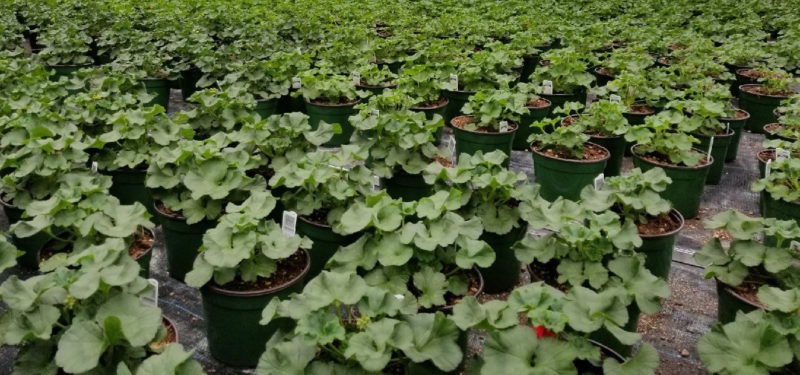
Water & Plant Health
As one of the most basic components of successful production, water seems deceptively simple in its utilization. But an irrigation method’s impact on plants — and plant quality in particular — has become increasingly apparent in recent grower trials, which found that bottom-up watering using capillary mats provides more consistent, better-quality plants.
UNDERSTANDING CAPILLARY ACTION
Capillary mats take advantage of soil’s natural capillary action. But what does that mean? Capillary action, also known as capillarity, is also seen when sponges soak up liquid. Just as sponges have holes in them, soil has spaces between its particles. These spaces are called pores, and water moves upward into them.
Water moves by cohesion or adhesion. You see cohesion when two water molecules are attracted to each other. You see adhesion when a water molecule clings to soil. Capillary action combines the two to move water into soil pores. Capillary action is stronger than the pull of gravity, so this movement is upward and horizontal, where roots can reach it.
STRONGER, HEALTHIER ROOTS
“We started using capillary mats mostly for a time-savings measure and to do less hand watering,” says Kyle Peterson, production manager at Fessler Nursery, Woodburn, Oregon. “Then we noticed that the crops that used capillary mats were more consistent and had more even growth.”
Fessler’s trial included geraniums and poinsettias, and they saw a difference in crop quality for both sections. “It’s really made a difference in our geraniums, which prefer not to be overhead watered, especially when they’re in bloom,” Peterson says. “And also on our poinsettias, which are the same way.”
Growers using the mats report stronger root systems and less shrinkage with fewer lost plants than usual. In fact, Denver’s Botany Lane Greenhouse estimates its poinsettia loss at just 0.5 percent or less.
Head Grower Daniel Ortega also trialed capillary mats on cordyline and has now moved most of his production to mats. He noted stronger root growth supported by better foliage, healthier-looking cuttings and more uniform foliage growth.
BETTER ENVIRONMENT FOR PLANTS, NOT PATHOGENS
“No water on the floor, ergo no moisture, ergo no soil, ergo no algae, ergo no bugs and diseases,” Ortega says.
In fact, the number one reason Botany Lane switched to capillary mats was keeping plant foliage drier. Daniel reports he has nearly eliminated the foliar pathogen Botrytis with the use of capillary mats. He attributes this to reduced overhead misting and less moisture on the foliage.
In addition, the WaterPulse mats Daniel uses were engineered with antimicrobial properties in their center geotextile layer. This provides a better plant environment, reducing algae development and preventing odors. Joe Walker also uses the mats and reports similar results, with fewer waterborne diseases at Obra Verde Growers in Valley Center, California. With no water runoff, they don’t have weeds to host pests and potential pathogens, and they’ve been able to eliminate under-bench preventive spraying.
FASTER PRODUCTION TIME
Watering with capillary mats, Botany Lane has also seen shorter production time on its crops. Ortega reports that he has greatly reduced the amount of time for the cuttings to take root. For example, on Imperial geraniums, what used to take three to four weeks, he can accomplish within four days using capillary mats for watering.
At Obra Verde, Joe Walker also reports faster production, with liners finishing in two-thirds the time they do with hand watering. He attributes this to less stress, less pathogen pressure and more even watering.
Ortega has seen similar results on regal geraniums, known as difficult to grow due to their precise watering period requirements. Root growth with traditional watering methods takes approximately four to eight weeks. Using capillary mats in trials, Botany Lane reduced this to just two weeks on three out of four plug trays.
Hibiscus production also showed improvement, with rooting structures within just two weeks of post cutting initiation. Daniel reports that on average, rooting structures form after four weeks with traditional watering.
BONUS: WATER AND LABOR SAVINGS
Of course the labor and water savings of capillary mats aren’t to be ignored either, says Peterson: “We save about 14 hours of watering — it’s substantial.”
Speedling’s Tad Kato agrees, saying, “We’re seeing at least 50 to 60 percent savings in water, and labor savings have been good also.” Trialing capillary mats on poinsettias at two locations in Watsonville and Nipomo, California, Kato says the system produced results with two short 10 to 15 minute sessions of watering in the morning and again in the afternoon.
“With the drought in California we need to take every opportunity we can to save water and also labor efficiency,” he says.









 Video Library
Video Library 


















